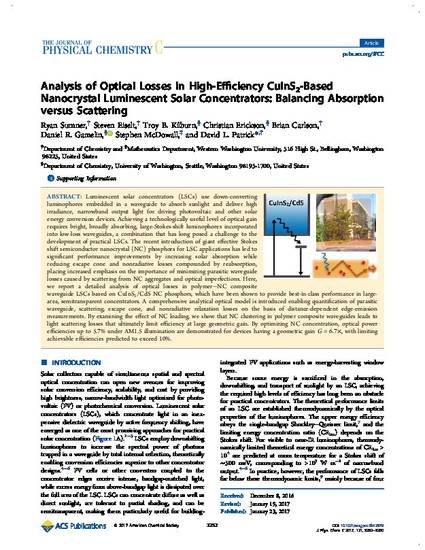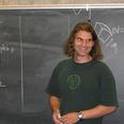
Article
Analysis of Optical Losses in High-Efficiency CuInS2-Based Nanocrystal LSCs - Balancing Absorption versus. Scattering
The Journal of Physical Chemistry C
(2017)
Abstract
Luminescent solar concentrators (LSCs) use down-converting luminophores embedded in a waveguide to absorb sunlight and deliver high irradiance, narrowband output light for driving photovoltaic and other solar energy conversion devices. Achieving a technologically useful level of optical gain requires bright, broadly absorbing, large-Stokes-shift luminophores incorporated into low-loss waveguides, a combination that has long posed a challenge to the development of practical LSCs. The recent introduction of giant effective Stokes shift semiconductor nanocrystal (NC) phosphors for LSC applications has led to significant performance improvements by increasing solar absorption while reducing escape cone and nonradiative losses compounded by reabsorption, placing increased emphasis on the importance of minimizing parasitic waveguide losses caused by scattering from NC aggregates and optical imperfections. Here, we report a detailed analysis of optical losses in polymer−NC composite waveguide LSCs based on CuInS2/CdS NC phosphors, which have been shown to provide best-in-class performance in large area, semitransparent concentrators. A comprehensive analytical optical model is introduced enabling quantification of parasitic waveguide, scattering, escape cone, and nonradiative relaxation losses on the basis of distance-dependent edge-emission measurements. By examining the effect of NC loading, we show that NC clustering in polymer composite waveguides leads to light scattering losses that ultimately limit efficiency at large geometric gain. By optimizing NC concentration, optical power efficiencies up to 5.7% under AM1.5 illumination are demonstrated for devices having a geometric gain G = 6.7×, with limiting achievable efficiencies predicted to exceed 10%.
Keywords
- LSC,
- luminescent solar concentrator,
- scattering,
- nanocrystal
Disciplines
Publication Date
Winter January 23, 2017
DOI
10.1021/acs.jpcc.6b12379
Citation Information
Stephen R. McDowall, Ryan I Sumner, Troy B. Kilburn, Christian Erickson, et al.. "Analysis of Optical Losses in High-Efficiency CuInS2-Based Nanocrystal LSCs - Balancing Absorption versus. Scattering" The Journal of Physical Chemistry C Vol. 121 Iss. 6 (2017) p. 3252 - 3260 Available at: http://works.bepress.com/stephen_mcdowall/8/
